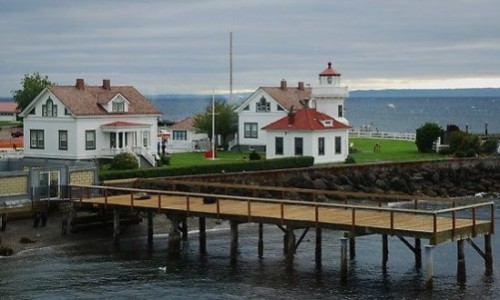By Margaret Robe Summitt, Mukilteo Historical Society
Logger John H. Davis was built to cut down trees. Six foot two, powerful shoulders, long legs. He matched his strength with the best of them at the slightest provocation or challenge. He bought timber land and sold it and made a profit, for a time. But he died penniless.
John H. Davis was living in Coupeville on Whidbey Island in 1871, with his father, William, a native of Wales, and his brothers Charles and Daniel. John was born in the state of Maine in about 1848. He came out to Washington about 1870, and worked as a logger near Snohomish, in a camp headed by Martin Getchell.
John was married for the first time about 1873. His first wife’s name is unknown. At about this time he was living at Preston Point (Hibulb), where he diked the tidal flat.
Then, on or about November 18, 1875, a murder took place on Hat Island. When “French Peter” Goutrie, the island’s only resident, failed to come to Mukilteo to pick up his mail, Morris Frost went to investigate and found Goutrie had been murdered, probably for the money he was rumored to have hidden. Goutrie’s estate was sold and John H. Davis bought the homestead for $525 from the public magistrate. Davis then partnered with Amos Phinney of Port Ludlow and logged off all the virgin timber on Hat Island.
After Davis made a bit of money, he married again. On June 8, 1878, Morris Frost as justice of the peace solemnized the marriage of John H. Davis and fourteen-year-old Mary Harvick. At that time John had sons Charles and Orville. The children of his second marriage were Johnnie, Daniel, Orville (a younger Orville b. 1889), Ernest, Albert, Abbie, Viola and Thelma.
Daughter Abbie was born July 6, 1898 in Mukilteo and died January 16, 1910 of cerebro-spinal meningitis. Daughter Viola died March 22, 1912 at age 11 of tubercular meningitis. It is not known what relation Stuart Davis was to the family. No son named Stuart is listed in census records. He may have been a son of John Davis’s first marriage. Abbie, Viola and Stuart Davis are buried in the Mukilteo Pioneer Cemetery. They have bronze plaques near the edge of the bluff.
It is not known when Davis bought the land where the Delta railroad yards in Everett are now located. When he sold it, circa 1915, he received $250,000 in two installments. After about a year he spent the entirety of the first installment of his payment. When he showed up to collect the second installment, he was shabbily dressed and in a state of dissipation. He ended up as a charity case at the county farm in Monroe, from which he disappeared in 1919. His skeleton was not discovered until December 1931. Apparently he had walked along the railroad grade in the direction of Snohomish and died as he was crossing a section of land near the Charles Frye farm. Coroner Nicholas Challacombe recognized that the skeleton, being that of a large man, might well have been that of Davis. A unique pocket watch was discovered on the body. Advertisement was made among Everett’s jewelers, and identification was confirmed with the help of a former Mukilteo neighbor, Max Fairfield, who recognized the engravings of an engine, coach and sailboat on Davis’s pocket watch. That watch, he said, was “one in a million.” Davis was buried in the G. A. R. Cemetery in Snohomish.


John Davis built his house near the present southwest corner of 5th and Lincoln, and it is considered one of the very first houses built in Mukilteo. It’s a small wooden house, presently painted blue, with a double set of concrete steps leading up to its porch. Although it looks small on the outside, a visitor in the early years recalled a luxurious interior and an attractive winding stairway. Today it houses a restaurant. Few are aware of its history or of the life of its builder.
Originally published in the 7/4/2018 issue of the Mukilteo Beacon.
